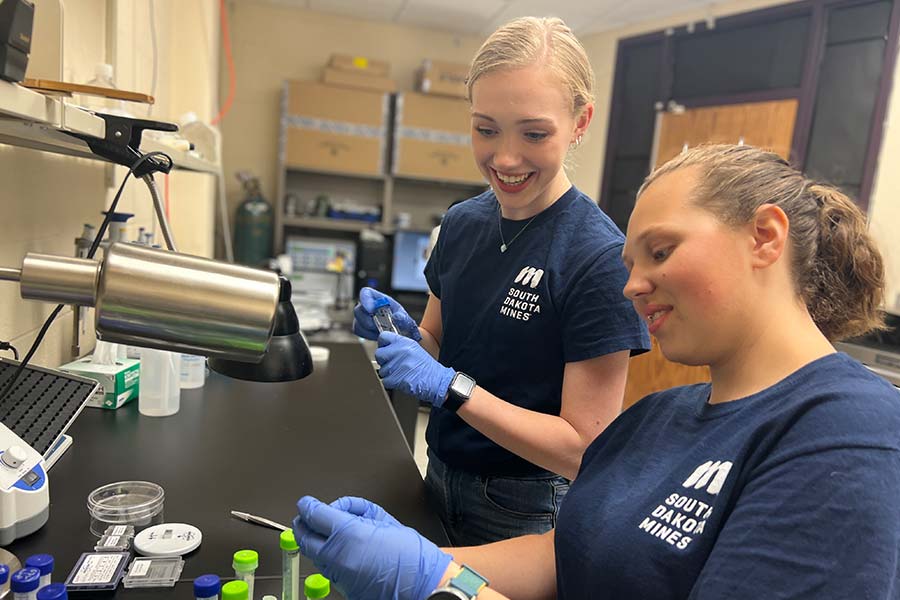Congzhou Wang, Ph.D., assistant professor of
nanoscience and biomedical engineering at South Dakota
Mines, and Steve Smith, Ph.D., professor and head of the
Department of Nanoscience & Biomedical Engineering, have received a research
grant from the National Cancer Institute (NCI) under the National Institutes of
Health to study the use of black phosphorous nanosheets and near-infrared
lasers in an effort to reverse the progression of breast cancer, making
conventional chemotherapy safer and more effective.
“We were very pleased to receive NCI funding,” says
Wang. “This is the federal government's principal agency for cancer research.
It’s highly competitive.” Wang notes that only about 10% of the proposals for
NCI funding are approved.
Wang and his team are studying the use of black
phosphorous,
which is biocompatible and biodegradable, so it won’t harm normal cells. Wang’s
research team first manufactures very thin sheets of black
phosphorous to dimensions of about 100 nanometers across by three nanometers
thick. For comparison, a human hair is about 80,000 - 100,000 nanometers thick.
The team then modifies the surface of the black
phosphorous nanosheets with an antibody that can specifically recognize the
receptors on chemotherapy-resistant breast cancer cells. The cancer cells then uptake
the nanosheets. Once the cell is full of black phosphorous, Wang’s team fires a
near-infrared laser targeting the tumor. Near-infrared lasers can penetrate the
skin and surrounding tissue into the tumor. The laser causes the black
phosphorous inside the cell to heat up.
“It’s very easy to understand. If you wear a dark jacket
in the summer, you are going to be hot,” says Wang. “This is the same thing,
once we shine the laser on the cells that are full of black phosphorous, they
heat up.”
Heating the cancer cells too much can cause the
surrounding healthy tissue to burn, but Wang’s research found that heating the
cells a small amount, to an increase of about five degrees Celsius, caused the more
advanced chemotherapy-resistant forms of breast cancer to stop migrating and
revert to earlier stages that are more easily treated with traditional
chemotherapy.
“We don’t need to kill the cancer cell with the
nanomaterial, we just need to stop metastasis of the cancer cell and make it
more susceptible to chemotherapy,” says Wang. “We’re using nanomaterial to
change the biology and improve the chemo-response of the cancer cells.”
Wang credits a portion of his success to the
interdisciplinary collaboration and concerted efforts of the state, Mines and
his colleagues in the department of nanoscience and biomedical engineering in
establishing the infrastructure and expertise needed for the project. Additionally,
Wang credits the contributions of project coinvestigator, Dr. Steve Smith, for
work in the university’s nanophotonics lab including super-resolution imaging
of cancer cells as they change with this treatment. Wang and Smith say this
research would not be possible without the support provided by the South Dakota
Board of Regents Collaborative Research award IMAGEN (Imaging, Materials and
Genetic Engineering): Biomaterials Research in South Dakota.
Wang also praises his students for the research success
achieved so far. “I especially need to thank my graduate student, Jinyuan Liu,
lead author on their recent paper published in the
prestigious journal ACS
Nano, which laid the
foundation for this successful NCI proposal,” says Wang.
 Part of the NCI R15 grant criteria focuses
specifically on involving undergraduate students in the future cancer research.
Wang teaches introductory courses in biomedical
engineering at Mines, and he often recruits students early in their
college careers to work in his laboratory. “I find great benefit in teaching
these entry level courses because I can find the students who are passionate
about this work,” says Wang. “We will be recruiting more undergraduates each
summer as this research unfolds in the coming years.”
Part of the NCI R15 grant criteria focuses
specifically on involving undergraduate students in the future cancer research.
Wang teaches introductory courses in biomedical
engineering at Mines, and he often recruits students early in their
college careers to work in his laboratory. “I find great benefit in teaching
these entry level courses because I can find the students who are passionate
about this work,” says Wang. “We will be recruiting more undergraduates each
summer as this research unfolds in the coming years.”
Annaliese Braucht, a sophomore biomedical
engineering student, spent the summer of 2022 working in Wang’s team. “To get
on such an incredible research opportunity in such a ground-breaking field, as
an undergrad, there is not really a feeling like it, because you know your work
can impact so many lives,” says Braucht.
“We have a few family members who have had cancer in
the past, this gives you more drive and motivation to undertake this work,”
adds Katherine Ballard, junior biomedical engineering major.
Students like Braucht and Ballard are exactly the
types of undergrads the NCI funded research hopes to inspire and empower. “Both
of these students have the real potential and motivation to do graduate level
research in the future, and the experience they are getting this summer can set
them up for future breakthroughs,” says Wang.
Wang’s team will spend the next three years on this
research; this work will continue alongside other research projects already
underway that are tied to Wang’s recent
NSF CAREER Award.